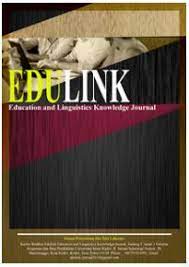Analysing Pedagogic Discourse through the Teachers' Use of Space in EFL Classrooms
Abstract
In language classrooms, the use of space has the same potential as language in shaping the pedagogical process. This study analyzes different types of classroom space and how they are used by two teachers to make different meanings. The analysis was carried out by focusing on the positioning of the teachers during lesson stages, namely Openings, Sequencing, and Closings based on the semantic categories of classroom space developed by Lim et al. (2012). The results explicated the use of four different types of space, namely authoritative space, personal space, supervisory space, and interactional space to create learning experience and how they are redefined by the teachers for specific reasons. The findings of this study are expected to provide insight as to how classroom space as one of the semiotic resources is crucial to the pedagogical process and therefore offers a way for teachers to evaluate and transform how they approach their teaching.
References
Bezemer, J. & C. Jewitt (2010). Multimodal analysis: Key issues. In L. Litosseliti (ed), Research methods in linguistics (pp. 180-197). Continuum.
Brooks, DC (2011). Space matters: the impact of formal learning environments on student learning. British Journal of Educational Technology, 42(5), 719–726.
Creswell, J.W. (2012) Educational research: Planning, conducting, and evaluating quantitative and qualitative research (4th ed.). Pearson.
Dempsey, N. P. (2010). Stimulated recall interviews in ethnography. Qualitative Sociology, 33, 349–367. https://doi.org/10.1007/s11133-010-9157-x
Flewitt, R. (2006). Using video to investigate preschool classroom interaction: Education research assumptions and methodological practices. Visual Communication, 5(1), 25–50. DOI: https://doi.org/10.1177/1470357206060917
Gana, E., Stathopoulou, C., Chaviaris, P. (2015). Considering the Classroom Space: Towards a multimodal analysis of the pedagogical discourse. In: U. Gellert, J.G. RodrÃguez, C. Hahn, S. Kafoussi. (eds) Educational Paths to Mathematics. Advances in Mathematics Education. Springer. https://doi.org/10.1007/978-3-319-15410-7_14
Givens, D. B. (2002). The nonverbal dictionary of gestures, signs, & body language cues. Center for Nonverbal Studies Press.
Irgin, P. (2017). Paralinguistics in Spoken English: Investigating the use of proxemixs and kinesics in an EFL context. International Journal of Linguistics, 9(3), 64-78. https://doi.org/10.5296/ijl.v9i3.11178
Jewitt, C. (2012). Multimodal methods for researching digital technologies. In S. Price, C. Jewitt, & B. Brown, The sage handbook of digital technology research. Sage.
Knaub, A.V., Foote, K.T., Henderson, C., Dancy, M., & Beichner, R.J. (2016). Get a room: the role of classroom space in sustained implementation of studio style instruction. International Journal of STEM Education, 3(8). https://doi.org/10.1186/s40594-016-0042-3
Komarawan, Y. (2019) Constructing interpersonal meaning in Indonesian science classrooms through language, space and gaze. KEMANUSIAAN the Asian Journal of Humanities, 26(1), 1–23, https://doi.org/10.21315/kajh2019.26.1.1
Lim, F.V. (2011) A systemic functional multimodal discourse analysis (SF-MDA) approach to classfroom discourse. Unpublished PhD dissertation, National University of Singapore.
Lim, F.V. (2019): Analysing the teachers’ use of gestures in the classroom: A Systemic Functional Multimodal Discourse Analysis approach. Social Semiotics, 29(1), 83-111. https://doi.org/10.1080/10350330.2017.1412168
Lim, F.V., O’Halloran, K. and Podlasov, A. (2012) Spatial pedagogy: Mapping meanings in the use of classroom space. Cambridge Journal of Education, 42(2), 235–251. https://doi.org/10.1080/0305764x.2012.676629.
Lippman, PC (2010). Can the physical environment have an impact on the learning environment? CELE Exchange, Centre for Effective Learning Environments, 1–6. https://doi.org/10.1787/20727925
Martin, SH (2002). The classroom environment and its effects on the practice of teachers. Journal of Environmental Psychology, 22, 139–156.
Matthiessen, C. I. M. (2010). Multisemiosis and context-based register typology: Registeral variation in the complementarity of semiotic systems. In E. Ventola & J. Moya (Eds.), The world told and the world shown: Multisemiotic issues (pp. 11–38). Palgrave Macmillan.
McGregor, J. (2004) Spatiality and the place of the material in schools. Pedagogy, Culture and Society, 12(3), 347-372. Htpps://doi.org/10.1080/14681360400200207
Norris, S. (2004). Analyzing multimodal interaction: A methodological framework. Routledge.
Richards, J. C., & Bohlke, D. (2011). Creating effective language lessons. Cambridge University Press.
Taylor, R. (2014). Meaning between, in and around words, gestures and postures – multimodal meaning-making in children’s classroom discourse. Language and Education, 28(5), 401–420. https://doi.org/10.1080/09500782.2014.885038.
Taylor, S.S. (2009). Effects of studio space on teaching and learning: preliminary findings from two case studies. Innovative Higher Education, 33(4), 217–228.
Unsworth, L. (2006). Toward a metalanguage for multiliteracies education: Describing the meaning-making resources of language-image interaction. English Teaching: Practice and Critique, 5(1), 55-76.

This work is licensed under a Creative Commons Attribution 4.0 International License.
This work is licensed under a Creative Commons Attribution License























 This work is licensed under a
This work is licensed under a  https://orcid.org/0000-0001-9166-6040
https://orcid.org/0000-0001-9166-6040
